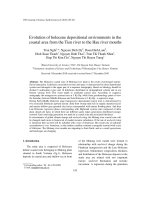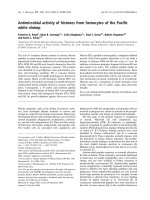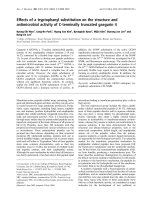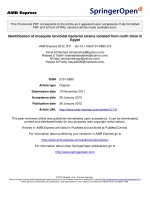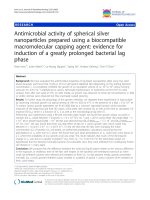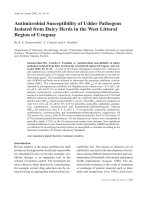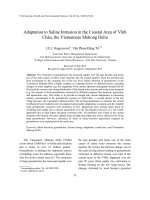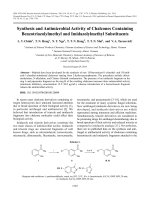Identification and antimicrobial activity of actinomycetes strains isolated from samples collected in the coastal area of Hue, Da Nang and Quang Nam provinces, Vietnam
Bạn đang xem bản rút gọn của tài liệu. Xem và tải ngay bản đầy đủ của tài liệu tại đây (1.66 MB, 8 trang )
Journal of Biotechnology 15(4): 737-744, 2017
IDENTIFICATION AND ANTIMICROBIAL ACTIVITY OF ACTINOMYCETES
STRAINS ISOLATED FROM SAMPLES COLLECTED IN THE COASTAL AREA OF
HUE, DA NANG AND QUANG NAM PROVINCES, VIETNAM
Cao Duc Tuan1,2,3, Le Thi Hong Minh1, *, Vu Thi Quyen1, Nguyen Mai Anh1, Doan Thi Mai Huong1,
Chau Van Minh1, Pham Van Cuong1
1
Institute of Marine Biochemitry, Vietnam Academy of Science and Technology
Hai Phong University of Medicine and Pharmacy
3
Graduate University of Science and Technology, Vietnam Academy of Science and Technology
2
*
To whom correspondence should be addressed. E-mail:
Received: 18.7.2017
Accepted: 25.10.2017
SUMMARY
Microorganisms are of particular interest because of their ability to synthesize high-value secondary
compounds and provide us with novel and diverse chemical structures. The most common source of antibiotics
is Actinomycetes which provide around two-third of naturally occurring antibiotics, including many of medical
importance. In this study, 81 strains of actinomycetes were isolated from 145 samples including: sediments,
sponges, soft corals, echinoderms and starfish collected from three sea areas of Vietnam: Hue, Da Nang and
Quang Nam. The strains were fermented in A+ medium and fermentation broths were extracted 5 times with
ethyl acetate. The extracts were evaporated under reduced pressure to yield crude extracts. Quantitative assay
was used to determine MIC (Minimum inhibitory concentration) of extract against 7 reference strains. From
the results of screening, Seven strains of actinomycetes that have the highest biological activity (Code: G244,
G246, G261, G266, G278, G280 and G290) were chosen to be identified by morphological and phylogenetic
based on 16S rRNA gene sequences. The results showed that 6 strains G246, G261, G266, G278, G280 and
G290 belonged to the genus Streptomyces; and the strain G244 belonged to the genus Micromonospora. In
particular, strains G244, G278, G280 were resistant 5/7 strains of microorganisms test, with values MICs from
2 µg/mL to 256 µg/mL; and three strains G261, G266, G290 showed the inhibitory effect towards 4/7 strains of
microorganisms test, with respective values MICs from 2 µg/mL to 256 µg/mL. Moreover, six of the seven
selected strains were highly resistant to yeast Candida albicans ATCC10231 with MIC values from 2 µg/mL
to 256 µg/mL. These results indicated that marine Actinomycetes in Vietnam are also a potential source to find
bioactive substances.
Keywords: 16S rRNA gene sequences, Actinomycetes, Antimicrobial activity, Micromonospora, Streptomyces
INTRODUCTION
Actinomycetes are diverse group of Gram positive bacteria that usually grow by filament
formation. They belong to the order Actinomycetales
with high G+C (>55%) content in their DNA. In fact,
the most common source of antibiotics is
Actinomycetes which provide around two-third of
naturally occurring antibiotics, including many of
medical importance (Okami, Hotta 1988). Aquatic
actinomycetes are of biological importance because
of their efficiency in antibiotic production. They are
considered highly valuable for producing various
antibiotics and other therapeutically useful
compounds with diverse biological activities. Many
of the presently used antibiotics such as
streptomycin,
gentamicin,
rifamycin
and
erythromycin are the products of actinomycetes. The
genus Streptomyces is represented in nature by the
largest number of species and varieties, producing
the majority of known antibiotics among the family
Actinomycetaceae. Streptomyces are well known
sources of antibiotics and other important novel
metabolites, including antifungal agents, antitumor
agents, antihelminthic agents and herbicides (Lee et
al., 2003; Thakur et al., 2007).
737
Cao Duc Tuan et al.
reported on their antimicrobial activity.
Though the recent search for novel antibiotics
have established approach of target based discovery
using bacterial genomics, combinatorial chemistry,
these powerful tools have not yet yielded any
antibiotics approved for clinical use, and the
prospects for their success are not encouraging
(Baltz, 2007). Another way, programs aimed at the
discovery of antibiotics from microbial sources have
yielded an impressive number of compounds over
the past 50 years, many of which have application in
human medicine and agriculture (Busti et al., 2006).
Therefore, the traditional method of screening
antibiotics from microorganisms is still very
effective (Baltz, 2007).
MATERIALS AND METHODS
Microorganism test
The microorganisms used for antibacterial test
were from ATCC Collection: Three Gram negative
bacteria (Escherichia coli ATCC25922, Pseudomonas
aeraginosa
ATCC27853,
Salmonella
enteric
ATCC13076), and three Gram positive bacteria
(Enterococcus faecalis ATCC29212, Stapphylococus
aureus ATCC25923, Bacillus cereus ATCC 13245 ),
one yeast strain Candida albicans ATCC10231.
Sample collection
It is obvious that actinomycetes serve as an
abundant source of bioactive compounds. In the future,
manifold novel compounds would be potentially
discovered from them. Herein, we reported on the
isolation, taxonomic characterization, extraction
fermentation broths with ethyl acetate of these
actinomycete strains isolated from samples collected in
Hue, Da Nang and Quang Nam of Vietnaman also
The marine samples were collected using Ponar
from three locations in Hue, Da Nang and Quang
Nam at 4 - 24 m depth with different geographic
coordinates (Table 1), the water at temperatures was
26-29oC. The samples were collected into 15 mL or
50 mL sterile Falcon tubes, preserved in ice-box and
processed within 24 h.
Table 1. Detail of the samples collected from three different locations: Hue, Da Nang and Quang Nam.
Locations
geographic coordinates
Hue (Mui Tho Lo in Hai Van)
16 13’3’’-108 7’57’’
No of samples
Water depth (m)
Collection time
0
0
21
5 – 24
26. 05. 2016
0
0
8
6
27. 05. 2016
Hue (Bai Chuoi, Son Cha in
Hai Van)
16 13’1’’-108 8’37’’
Hue (BanhTranh, Son Cha
in Hai Van)
16 12’58’’-108 7’59’’
Quang Nam (Hon Tai in Cu
Lao Cham)
15 54'13"-108 31'54"
Quang Nam (Hon La in Cu
Lao Cham )
15 58'19"-108 27'7"
Quang Nam (Hon Mo in Cu
Lao Cham)
15 55'50"-108 28'30’’
Quang Nam (Hon Dai in Cu
Lao Cham)
15 56'24"-108 28'56’’
Đa Nang (Son Tra)
16 11’37 – 108 11’43
0
0
3
5
27. 05. 2016
0
0
16
4
19. 09. 2016
0
0
11
3
01. 10. 2016
0
0
19
3–7
01. 10. 2016
0
0
24
4 – 90
02. 10. 2016
0
0
5
16 – 20
24. 08. 2016
0
0
23
10
24. 08. 2016
0
0
15
7
25. 08. 2016
Đa Nang (Northeast of the
Son Tra)
16 09’11 – 108 13’50
Đa Nang (Northeast of the
Son Tra)
16 34’50 – 108 11’4
Isolation of actinomycetes
First, 0.5 g of sample was suspended in 4.5 mL
of sterile distilled water, homogenized by vortexing
for 1 min, and the suspension was treated using a
wet-heat technique (60oC for 6 min). Next, 0.5 mL
738
of this suspension was transferred to another 4.5 mL
sterile distilled water and this step was repeated to
set up a ten fold dilution series to 10-3. At the final
dilution step, aliquots of 50 µL were spread on six
different media including A1 (soluble starch: 10 g/L;
yeast extract: 4 g/L peptone: 2 g/L; instant ocean: 30
Journal of Biotechnology 15(4): 737-744, 2017
g/L; agar: 15 g/L); M1 (soluble starch: 5 g/L; yeast
extract: 2 g/L; peptone: 1 g/L; instant ocean: 30 g/L;
agar: 15 g/L), SWA (instant ocean: 30 g/L; agar: 15
g/L); A+( soluble starch: 10 g/L; yeast extract: 4 g/L;
peptone: 2 g/L; instant ocean: 30 g/L; CaCO3: 1 g/L;
agar: 15 g/L), SCA (soluble starch: 10 g/L; K2HPO4:
2 g/L; KNO3: 2 g/L; casitone: 300 mg/L;
MgSO4·7H2O: 50 mg/L; FeSO4·7H2O: 10 mg/L;
instant ocean: 30 g/lL CaCO3: 2 mg/L; agar: 15 g/L),
NZSG (soluble starch: 20 g/L; yeast extract: 5 g/L
glucose: 10 g/L; NZ amine A: 5 g/L; instant ocean:
30 g/L; agar: 15 g/L); ISP1 (soluble starch: 5 g/L;
yeast extract: 2 g/L; casitone: 5 g/lL instant ocean:
30 g/L; agar: 15 g/L), ISP2 (soluble starch: 5 g/L;
yeast extract: 2 g/L; malt extract: 10 g/L; glucose: 10
g/L; instant ocean: 30 g/L; agar: 15 g/L). These
media were supplemented with 50 µg/mL polymycin
B and cycloheximide to inhibit Gram - negative
bacterial and fungal contamination. After 21 days of
aerobic incubation at 28oC, the colonies of
actinomycete strains were transferred onto A1 agar
medium (Williams et al., 1965, 1971 ).
Extraction crude and screening the antimicrobial
activity of the extracts
The actinomycetes strains were cultivated at
28°C in sterile 1000 mL flasks containing 500 mL
media A+ with glucose 1%, pH 7.0, at 200 rpm. After
7 days of cultivation, the fermentation broths were
filtered and then extracted 5 times with ethyl acetate.
The extracts were evaporated under reduced pressure
to yield crude extracts (Cédric et al., 2013).
Crude extracts were tested against the Grampositive bacteria (B. cereus ATCC13245, E. faecalis
ATCC29212, S. aureus ATCC25923), the Gramnegative bacteria (P. aeruginosa ATCC27853, E.
coli ATCC25922, S. enterica ATCC13076) and the
fungi C. albicans ATCC10231. The positive control
was streptomycin for bacteria, and nystatin for fungi
C. albicans ATCC10231. Quantitative assay was
done by dilution method for determination of MIC
(Minimum Inhibition Concentration) values of
extracts against the test bacteria. MIC means the
lowest concentration of extract at which the test
microorganism did not show any visible. The density
of cells was read at 610 nm and adjusted to an
optical density (OD) of 0.04 for Gram-positive
bacteria, and 0.05 for Gram-negative bacteria and C.
albicans. Aliquots of 50 µL of bacterial or fungal
suspension were incubated with each crude extract
for 24 h at 30ºC. The UV absorption of each sample
was read at 610 nm and compared against the UV
absorption of the media as control. MIC value was
determined in wells with the lowest concentration of
reagents that completely inhibits the growth of
microorganisms after 24 h of incubation and was
correctly identified based on data of cell turbidity
measured by spectrophotometer Biotek and
GraphPadPrism DaTa software (Hadacek et al.,
2000).
Identification of actinomycetes
The actinomycete strains were grown for 14
days at 28ºC on starch casein agar (SCA) and
examined using scanning electron microscopy
(model JSM-5410 LV; JEOL). Samples for scanning
electron microscopy (SEM) were prepared as
described by Itoh (1989).
Sequences of the 16S rRNA gene were used for
identification of choosen strains. PCR amplifications
were performed in a 25.0 µL mixture containing:
16.3 µL of sdH2O, 2.5 µL of 10X PCR buffer, 1.5
µL of 25 mM MgCl2, 0.5 µL of 10 mM dNTP’s, 0.2
µL of Taq polymerase, 1.0 µl for both 0.05 mM of 9
F (5'-GAGTTTGATCCTGGCTCAG3') and 0.05
mM of 1541R (5'-AAGGAGGTGATCCAACC3')
primers (Rajesh et al., 2013) and 2.0 µL of genomic
DNA. The reaction tube was then put into MJ
Thermal Cycler, which had been programmed to
preheat at 94oC for 3 min, followed by 30 cycles of
denaturation at 94oC for 1 min, annealing at 60oC for
30 s and elongation at 72oC for 45 s before a final
extension of 72oC for 10 min. The estimated PCR
product size was about 1500 bp. PCR products were
purified by DNA purification kit (Invitrogen) then
sequenced by DNA Analyzer (ABI PRISM 3100,
Applied Bioscience). Gene sequences were handled
by BioEdit v.2.7.5. and compared with bacterial 16S
rRNA sequences in GeneBank database by NBCI
Blast program. The alignment was manually verified
and adjusted prior to the construction of a
phylogenetic tree. The phylogenetic tree was
constructed by using the neighbor-joining the
MEGA program version 4.1 (Saitou et al., 1987).
RESULTS AND DISCUSSION
Isolation and screening the antimicrobial activity
of of actinomycetes
From 145 marine samples collected in Hue, Da
Nang and Quang Nam, 81 actinomycete strains were
isolated.These strains then were cultured and
extracted to screen biological activity. From the
739
Cao Duc Tuan et al.
results of screening, seven strains of actinomycetes
that have the highest biological activity (Code:
G244, G246, G261, G266, G278, G280 and G290)
were chosen (Table 2).
Table 2. Antimicrobial activity of crude ethyl acetate extracts from 7 strains.
S.No.
Isolates
E.faecalis
ATCC29212
MIC(µg/mL)
64
64
64
256
256
256
-
Unit
1
G244
2
G246
3
G261
4
G266
5
G278
6
G280
7
G290
Steptomycin
Nistatin
Gram-positive
S.aureus
B.cereus
ATCC25923
ATCC13245
MIC(µg/mL)
MIC(µg/mL)
256
128
256
16
256
32
256
32
256
128
-
The result reveals that most of the isolates were
active against both Gram positive and Gram negative
bacteria. Strains G244, G278, G280 were resistant 5/7
strains of microorganisms test, with values MICs
from 2 µg/mL to 256 µg/mL; and three strains G261,
G266, G290 showed the inhibitory effect towards 4/7
strains of microorganisms test, with respective values
MICs from 2 µg/mL to 256 µg/mL. In addition, six of
the seven strains selected were highly resistant to C.
albicans ATCC10231 with MIC values from 2
µg/mL to 256 µg/mL. Comparison of antimicrobial
activity among screening strains in Hue, Quang Nam
and Da Nang with isolated strains in the North - East
Coast of Vietnam showed that: 7 strains of
actinomycetes selected above have potent activity
against both Gram-positive and Gram-negative
bacteria. Of the 15 strains screened in the North-East
Coast of Vietnam, only four strains of G057, G115,
G119, and G120 were resistant to P. auruginosa
ATCC27853 with a MIC value of 64 - 32µg/mL (Le
Thi Hong Minh et al., 2016). This result shows that
the biological activity of the strains depends very
much on geographic location during sample
collection.
A
B
E.coli
ATCC25922
MIC(µg/mL)
128
16
16
32
-
Gram-negative
P.aeruginosa
ATCC27853
MIC(µg/mL)
16
32
32
16
256
-
S.enterica
ATCC13076
MIC(µg/mL)
32
16
16
8
128
-
Yeast
C.albicans
ATCC10231
MIC(µg/mL)
32
32
16
2
2
16
8
Identification of actinomycetes by morphological
characteristic
The spore morphology is considered as one of
the important characteristics in the identification of
Streptomyces and it greatly varies among the
species. It has been found that the majority of the
marine isolates produced aerial coiled mycelia and
the spores arranged in chains as already reported by
Mukherjee and Sen, 2004 (Fig. 1B, 1C, 1D).
Micromonospora species produced well-developed
and branched substrate hyphae on yeast extract-malt
extract medium, but no aerial hyphae. Spores were
borne singly on the substrate hyphae having an
approximate diameter of 0.5 - 1 µm. The spores were
nodular and smooth on the surface and non-motile
(Fig.1A).
The colors of the substrate mycelium were
yellowish white to vivid orange and turned to
brownish black to black after sporulation (Figure 2).
The morphological characteristics of these isolates
were consistent with their classification in the genus
(Kawamoto et al., 1989).
C
B
Figure 1. Scanning electron micrographs of the representative strains G244(A ); G246 (B); G266 (C), and G290 (D) grown
on SCA agar for 2 weeks at 30°C.
740
Journal of Biotechnology 15(4): 737-744, 2017
Figure 2. Morphological appearance of isolates. The colors of the substrate mycelium were vivid orange A(G244) and from
white turned to brownish after sporulation B(G246), C(G261), D(G266), E(G278), F(G280) and G(G290).
Identification of actinomycetes by phylogenetic
based on 16S rRNA gene sequences
Seven potential isolates were selected for
identification by 16S rRNA gene sequencing. The
obtained sequences were analysed by Bioedit
program and compared with those in GenBank
database. The obtained results showed that 16S
rRNA sequences of G246, G261, G266, G278, G280
and G290 strains exhibited high similarity (99%)
with genus Stretomyces spp; The strain G244 was
identified (99% similarity) of 16S rRNA gene
sequence with genus Micromonospora in GenBank)
(Figure 3).
Streptomyces is a genus of Gram-positive
bacteria that grows in various environments, with a
filamentous form similar to fungi. The
morphological
differentiation
of Streptomyces involves the formation of a layer of
hyphae that can differentiate into a chain of spores.
The most interesting property of Streptomyces is the
ability to produce bioactive secondary metabolites
such as antifungals, antivirals, antitumoral, antihypertensives, and mainly antibiotics and immune
suppressives (Patzer et al., 2010; Khan 2011).
Another characteristic of the genus is complex
multicellular development, in which their
germinating spores form hyphae. Then, multinuclear
aerial mycelium forms septa at regular intervals,
creating a chain of spores (Ohnishi et al., 2008).
Marine environment contains a wide range of
distinct Streptomyces that are not present in the
terrestrial environment. Though some reports are
available on antibiotic and enzyme production by
marine actinomycetes, the marine environment is
still a potential source for isolating new
actinomycetes, which can yield novel bioactive
compounds and industrially important enzymes (Cai
et al., 2007).
In addition, Micromonospora species – the
dominant actinomycetes are possible to be isolated
from aquatic habitats such as streams, lake mud,
river sediments, beach sands, sponge and marine
sediments (Rifaat, 2003; Eccleston et al., 2008).
Micromonospora
species,
together
with
Streptomyces species are best known for
synthesizing antibiotics, especially aminoglycoside,
enediyne, and oligosaccharide antibiotics. Thus, their
impact on medicine is considerable. Of common
antibiotics in the medical field, gentamicin and
netamicin belong to the aminoglycoside antibiotics
yielded by Micromonospora (Bérdy, 2005).
Research focused on marine environment has
been gaining importance in recent years. However,
still it has not been fully explored and there is
tremendous potential to identify novel organisms
with various biological properties. The present
investigation showed that actinomycetes tentatively
identified as Streptomyces species have strong
antimicrobial activities against pathogenic bacteria
(Sujatha et al., 2005; Ramesh et al., 2009).
741
Cao Duc Tuan et al.
Figure 3. Neighbor-joining tree based on almost-complete 16S rRNA gene sequences showing relationships between the
strains in groups and representative members of the genera Streptomyces and Micromonospora were used as an outgroup.
The numbers on the branches indicate the percentage bootstrap values of 1,000 replicates; Bar, 0.01 substitutions per
nucleotide position.
CONCLUSION
From 145 samples including sediments, sponges,
soft corals, echinoderms and starfish collected from
three sea areas of Vietnam: Hue, Da Nang, and
Quang Nam, 81 strains of actinomycetes were
isolated. Most of the isolates exhibited antimicrobial
activity, seven strains of actinomycetes that have the
highest biological activity were chosen to be
identified by morphological and phylogenetic
investigations based on 16S rRNA gene sequences.
The strains G246, G261, G266, G278, G280, and
G290 belonged to genus Stretomyces; strain G244
were identified as genus Micromonospora.
Specifically, All of the seven strains were resistant
from 4 to 5 out of 7 strains of microorganisms test,
with values MICs from 2 µg/mL to 256 µg/mL. In
addition, six of the seven strains selected were highly
resistant to yeast C Albicans ATCC10231with MIC
values from 2 µg/mL to 256 µg/mL. Research
results have shown that marine actinomycetes
isolated from the marine environment of Vietnam
promise to be a rich source of materials for
secondary bioactive compounds.
742
Acknowledgements: This work was financially
supported by the Vietnam Academy of Science and
Technology
(VAST).
Code
of
project:
VAST.TĐ.DLB.04/16-18.
REFERENCES
Baltz RH (2007) Antimicrobials from actinomycetes: Back
to the future. Microbe 2(3): 125-131.
Bérdy J (2005) Bioactive microbial metabolites: a personal
view. J Antibiot Tokyo 58: 1-26.
Busti E, Monociardini P, Cavaletti L, Bamonte R,
Lazzarini A, Sosio M and Donadio S (2006) Antibioticproducing ability by representatives of a newly discovered
lineage of Actinomycetes. Microbiology 152: 675-683.
Cai P, Kong F, Fink P, Ruppen ME, Williamson RT,
Keiko T (2007) Polyene antibiotics from Streptomyces
mediocidicus. J Nat Prod 70: 215-219.
Cédric O, Skylar C, Bindiya K, Mashal M A, Haipeng L,
Anna O, Quan S, Van Cuong Pham, Catherine L S, Brian
T M and S. Alexander M (2013) Tool for characterizing
bacterial protein synthesis inhibitors. Antimicrob Agents
Chemother 57(12): 5994-6002.
Journal of Biotechnology 15(4): 737-744, 2017
Eccleston G P, Brooks P R, Kurtboke D I (2008) The
occurrence of bioactive micromonsoporae in aquatic
habitats of the sunshine coast in Australia. Mar Drugs 6:
243-261.
Okami, Y and Hotta K (1988) Search and discovery of
new antibiotics. In: Actinomycetes in biotechnology.
Academic press London : 37-67.
Hadacek F, Greger H (2000) Test of antifungal natural
products methodolagies, comparability of result and assay
choise. Phytochem Anal 90: 137-147.
Patzer SI, Volkmar B (2010) Gene cluster involved in the
biosynthesis of griseobactin, a catechol-peptide
siderophore of Streptomyces sp. ATCC 700974. J
Bacteriol 192: 426-435.
Itoh T, Kudo T, Parenti F, Seino A (1989) Amended
description of the genus Kineosporia, based on
chemotaxonomic and morphological studies. Int J Syst
Bacteriol 39: 168-173.
Ramesh S, Rajesh M, Mathivanan N (2009)
Characterization of a thermostable alkaline protease
produced by marine Streptomyces fungicidicus MML1614.
Bioprocess Biosyst Eng 32: 791-800.
Khan ST (2011) Streptomyces associated with a marine
sponge Haliclona sp.; biosynthetic genes for secondary
metabolites and products. Environ Microbiol Black Sci
Pub 13: 391-403.
Rajesh M M, Subbaiya R, Balasubramanian M (2013)
Isolation and Identification of Actinomycetes Isoptericola
variabilis from Cauvery River Soil Sample. Int J Curr
Microbiol App Sci 2(6): 236-245.
Kawamoto I, Williams S T, Sharpe M E, Holt J G (1989)
Bergey’s Manual of Systematic Bacteriology 4: 2442-2450.
Rifaat H M (2003) The biodiversity of actinomycetes in
the River Nile exhibiting antifungal activity. J Mediter
Ecol.4: 5-7.
Lee HB, Kim CJ, Kim JS, Hong KS, Cho KY (2003) A
bleaching herbicidal activity of methoxyhygromycin
(MHM) produced by an actinomycete strain Streptomyces
sp.8E-12. Lett Appl Microbiol 36: 387–391.
Saitou N, Nei M (1987) The neighbor-joining method: a
new method for reconstructing phylogenetic trees. Mol
Biol 4: 406-425.
Le T H M, Vu T Q, Nguyen M A, Doan T M H, Murphy B
T, Chau V M, and Pham V C (2016) Isolation, screening
and identification of microorganisms having antimicrobial
activity isolated from samples collected on seabed of
Northeast Vietnam. Journal of Biotechnology 14(3): 539547.
Mukherjee G, Sen SK (2004) Characterization and
identification of chitinase producing Streptomyces
venezulae P10. Indian J Exp Biol 42: 541-544.
Ohnishi Y, Ishikawa J, Hara H (2008) Genome sequence
of
the
streptomycin-producing
microorganism Streptomyces griseus IFO 13350. J
Bacteriol 190: 4050-4060.
Sujatha P, Bapiraju KV, Ramana T (2005) Studies on a
new marine Streptomycete BT-408 producing polyketide
antibiotic SBR-22 effective against methicillin resistant
Staphylococcus aureus. Microbiol Res 160: 119–126
Thakur D, Yadav A, Gogoi BK, Bora T C (2007) Isolation
and screening of Streptomyces in soil of protected forest
areas from the states of Assam and Tripura, India, for
antimicrobial metabolites. J Mycol Med 17:242–249.
Williams S T and Davies F L (1965) Use of antibiotics for
selective isolation and enumeration of Actinomycetes in
soil. J Gen Microbiol 38: 251-261.
Williams S T, Cross T (1971) Actinomycetes in: Methods
in Microbiology. Academic Press (London) 4:295–334.
ĐỊNH DANH VÀ HOẠT TÍNH KHÁNG KHUẨN CỦA CÁC CHỦNG XẠ KHUẨN ĐƯỢC
PHÂN LẬP TỪ CÁC MẪU THU THẬP Ở VÙNG VEN BIỂN HUẾ, ĐÀ NẴNG VÀ QUẢNG
NAM
Cao Đức Tuấn1,2,3, Lê Thị Hồng Minh1, Vũ Thị Quyên1, Nguyễn Mai Anh1, Đoàn Thị Mai Hương1,
Châu Văn Minh1, Phạm Văn Cường1
1
Viện Hóa sinh biển, Viện Hàn lâm Khoa học và Công nghệ Việt Nam
Trường Đại học Y dược Hải Phòng
3
Học viện Khoa học và Công nghệ, Viện Hàn lâm Khoa học và Công nghệ Việt Nam
2
TÓM TẮT
Vi sinh vật được quan tâm đặc biệt bởi khả năng sinh tổng hợp các hợp chất thứ cấp có giá trị cao và cung
cấp cho chúng ta các cấu trúc hóa học mới lạ và đa dạng. Xạ khuẩn là nguồn sản xuất phổ biến nhất các chất
kháng sinh, khoảng 2/3 loại kháng sinh được phát hiện trong tự nhiên là từ xạ khuẩn. Trong nghiên cứu này,
chúng tôi phân lập được 81 chủng xạ khuẩn từ 145 mẫu gồm: trầm tích, hải miên, san hô mềm, da gai và sao
743
Cao Duc Tuan et al.
biển thu được từ 3 vùng biển của Việt Nam: Huế, Đà Nẵng và Quảng Nam. Các chủng đã được lên men trong
môi trường A+ và môi trường lên men được chiết xuất 5 lần với ethyl acetate. Các chất chiết xuất đã bay hơi
dưới áp suất giảm để tạo ra các cặn chiết thô. Phương pháp định lượng được sử dụng để xác định MIC (nồng
độ ức chế tối thiểu) của cặn chiết đối với 7 chủng vi sinh vật kiểm định. Từ kết quả sàng lọc, Từ các kết quả
sàng lọc, bảy chủng actinomycetes có hoạt tính sinh học cao nhất (Mã số: G244, G246, G261, G266, G278,
G280 và G290) được lựa chọn để định danh bằng hình thái học và phát sinh loài dựa trên trình tự gen 16S
rRNA. Kết quả cho thấy 6 chủng G246, G261, G266, G278, G280 và G290 thuộc về chi Streptomyces; và
chủng G244 thuộc chi Micromonospora. Đặc biệt, chủng G244, G278, G280 đã kháng được 5/7 chủng vi sinh
vật, với giá trị MICs từ 2 µg/mL đến 256 µg/mL; và ba chủng G261, G266, G290 cho thấy tác dụng ức chế đối
với 4/7 chủng vi sinh vật kiểm định, với giá trị tương ứng MICs từ 2 µg/mL đến 256 µg/mL. Ngoài ra, sáu
trong số bảy chủng được lựa chọn có hoạt tính ức chế nấm Candida albicans ATCC10231 rất cao với giá trị
MICs từ 2µg/mL đến 256 µg/mL. Những kết quả thu được cho thấy rằng các chủng xạ khuẩn biển ở Việt Nam
cũng là nguồn nguyên liệu tiềm năng để tìm kiếm các chất có hoạt tính sinh học.
744
